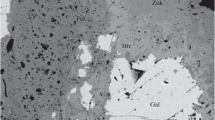Abstract
The new data for the segregations, paragenetic assemblage, and composition of bismuthian jamesonite from gold–quartz mineralization at the Sredny Golgotai deposit located in the eastern part of the Mongolia–Okhotsk orogenic belt are reported. This mineral occurs as two varieties (I, II), which are slightly different in composition and chemically close to bismuthian jamesonite (“sakharovaite”) described from the Ustarasai deposit. In contrast to variety II, variety I is Cu- and Fe-free. The electron microprobe study has revealed that varieties I and II are close to jamesonite and tintinaite, respectively. The data obtained make it possible to conclude that individual sulfosalt species of the proper tintinaite and jamesonite series, which are close in composition, are probable members of the tintinaite–kobellite series. It is assumed that the Cu- and Fe-free variety of bismuthian jamesonite close in composition to “sakharovaite” is an individual mineral species.




Similar content being viewed by others
REFERENCES
Borodaev, Yu.S. and Mosgova, N.N., About bismuth-antimony sulphosalts of lead from the Pochekuevskoe deposit (Eastern Transbaikalia), Geol. Rudn. Mestorozhd., 1975, vol. 17, no. 2, pp. 118–126.
Bortnikov, N.S., Mozgova, N.N., Nekrasov, I.Ya., Rozov, D.N., Tupyakov, V.E., and Tsepin, A.I., Features of bismuth mineralization in the gold ore deposit of Eastern Transbaikalia, Mineral. Zh., 1982, vol. 4, no. 4, pp. 45–58.
Bortnikov, N.S. and Tsepin, A.I., Antimony-bismuth sulphosalts from the Sredne-Golgotai deposit (Eastern Transbaikalia), Izv. Akad. Nauk SSSR, Ser. Geol., 1987, no. 1, pp. 86–95.
Burke, E.A.J., A mass discreditation of GQN minerals, Can. Mineral, 2006, vol. 44, pp. 1557–1560.
Dunin-Barkovskaya, E.A., Geokhimiya i mineralogiya vismuta (Chatkalo-Kuraminskie gory), (Geochemistry and Mineralogy of Bismuth (Chatkal–Kuraminskii Range)), Tashkent: FAN Uzb. SSR, 1978.
Gvozdev, V.I., Rudno-magmaticheskite sistemy skarnovykh sheelit-sul’fidnykh mestorozhdenii Vostoka Rossii, (Ore-Magmatic Systems of Scheelite–Sulfide Skarn Deposits of the Russian Far East), Vladivostok: Dal’nauka, 2010.
Harris, D.C., Jambor, J.L., Lachance, G.R., and Thore, R.I., Tintinaite, the antimony anologue of kobellite, Can. Mineral., 1968, vol. 9, no. 3, pp. 371–382.
Kostov, I., Bi-bearing jamesonite or sakharovaite - a new type of mineral, Tr. Mineral. Muzeya AN SSSR, 1959, vol. 10, pp. 1148–1149.
Kupcik, V., Die Kristallstruktur des Minerals (Cu,Fe)Pb9Bi12S28, Tscherm. Mineral. Petrogr. Mitt., 1984, vol. 32, pp. 259–269.
Kupcik, V., Schmider, A., and Varcek, C., Chemismus von einigen Bi-Sulfosalzen aus den Zips-Comorer Erzgebir ge (CSSR), M. Jb. Miner. Monatsch, 1969, vol. 10, no. 4, pp. 445–454.
Moëlo Y., Makovicky, E., Mozgova, N.N., Jambor, J.L., Cook, N., Pring, A., Paar, W., Nickel, E.H., Graeser, S., Karup-Møller S., Balic-Žunic, T., Mumme, W.G., Vurro, F., Topa, D., Bindi, L., Bente, K., and Shimizu, M., Sulfosalt systematics: a review. Report of the sulfosalt sub-committee of the IMA Commission on Ore Mineralogy, Eur. J. Mineral., 2008, no. 20, pp. 7–46.
Moëlo, Y., Roger, G., Maurel-Palacin, D., Marcoux, E., and Laroussi, A., Chemistry of Pb–(Cu,Fe)–(Sb, Bi)-sulfosalts from France and Portugal, and correlated substitutions in the Cu-poor part of the Pb2S2–Cu2S–Sb2S3–Bi2S3 system, Mineral. Petrol., 1995, vol. 53, pp. 229–250.
Mozgova, N.N., The Group of lead antimony–bismuth complex sulphides (sulphosalts), Izomorfizm mineralov, (Isomorphism of minerals), Moscow: Nauka, 1975, pp. 159–179.
Mozgova, N.N., Nestekhometriya i gomologicheskie ryady sul’fosolei (Nonstoichiomotery and Homological Series of Sulphosalts), Moscow: Nauka, 1985.
Mozgova, N.N., Nenasheva, S.N., Borodaev, Y.S., and Yudovskaya, M.A., Nuffieldite from the Maleevskoe massive sulfide deposit, Russia, Can. Mineral., 1994, vol. 32, pp. 359–364.
Nechelyustov, G.N. and Mymrin, V.A., About the first finding of kobellite in the USSR, Dokl. Akad. Nauk SSSR, 1968, vol. 181, no. 5, pp. 1223–1226.
Nickel, E.H. and Grice, J.D., The IMA Commission on New Minerals and Mineral Names; procedures and guidelines on mineral nomenclature, Can. Mineral., 1998, vol. 39, pp. 931–926.
Sakharova M.S. Typomorphism of bismuth-tellurium mineral associations in gold ore deposits of Eastern Transbaikalia, Tipomorfizm mineraloov i ego prakticheskoe znachenie (Mineral Typomorphism and its Practical Importance), Moscow: Nedra, 1972, pp. 233–240.
Sakharova, M.S. and Krivitskaya, N.N., Mineralogical and geochemical characteristics of lead-antimony-bismuth sulphosalts from the gold ore deposits of Eastern Transbaikalia, Geol. Rudn. Mestorozhd., 1970, vol. 12, no. 4, pp. 56–70.
Sakharova, M.S., About bismuth sulphosalts from the Ustarasai deposit, Tr. Mineral. Muz. Akad. Nauk SSSR, 1955, vol. 7, pp. 112–126.
Spiridonov, A.M., Zorina, L.D., and Kitaev, N.A., Zolotonosnye rudno-magmaticheskie sistemy Zabaikal’ya (Gold-Bearing Ore-Magmatic Systems of Transbaikalia), Novosibirsk: Geo, 2006.
Tupyakov, V.E., Geology and Endogenous Ore Zoning of the Sredne-Golgotai Gold–Bismuth Deposit (Eastern Transbaikalia), Extended (Geol-Min) Abstract, Irkutsk: Polytechnic Institute, 1978.
Wagner, T. and Jonsson, E., Mineralogy of sulfosalt-rich vein-type ores, Boliden massive sulfide deposit, Skellefte district, northern Sweden, Can. Mineral., 2001, vol. 39, pp. 855–872.
Zakrzewski, M.A. and Makovicky, E., Izoklakeite from Vena, Sweden, and the kobellite homologous series, Can. Mineral., 1986, vol. 24, pp. 7–18.
ACKNOWLEDGMENTS
We thank V.E. Tupyakov, A.V. Tupyakov, and researchers of the Laboratory of Geochemistry of Ore Formation and Geochemical Methods of Prospecting at the Institute of Geochemistry, Siberian Branch Russian Academy of Sciences for their assistance in field works at the deposit, and G.B. Molchanova and N.I. Ekimova from Laboratory of X-ray methods in Analytical Center of Far East Geological Institute, Far East Branch, Russian Academy of Sciences for their assistance and analytical study.
Funding
This study has been partly supported by the Russian Foundation for Basic Researches (project nos. 15-05-00809, 16-05-00283, 16-35-60098) and Far East Branch, Russian Academy of Sciences (grant 15-I-2-003o).
Author information
Authors and Affiliations
Corresponding authors
Additional information
Translated by I. Baksheev
Rights and permissions
About this article
Cite this article
Vakh, A.S., Gvozdev, V.I., Goryachev, N.A. et al. Bismuthian Jamesonite (“Sakharovaite”) in Ores of the Sredny Golgotai Gold Deposit, Eastern Transbaikal Region, Russia. Geol. Ore Deposits 61, 791–802 (2019). https://doi.org/10.1134/S1075701519080129
Received:
Revised:
Accepted:
Published:
Issue Date:
DOI: https://doi.org/10.1134/S1075701519080129



